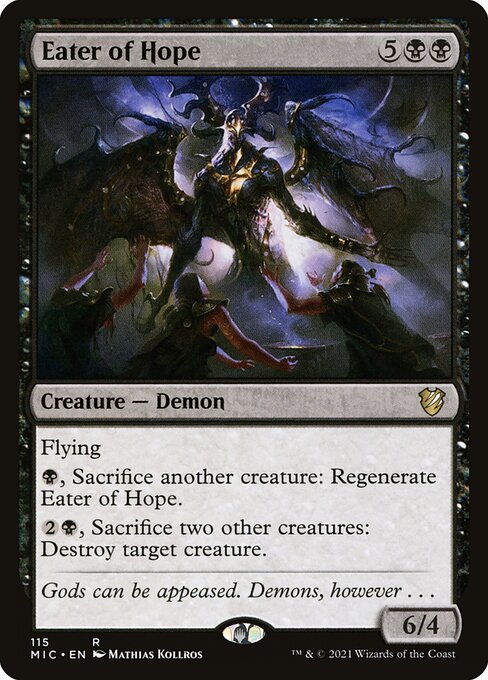
Image courtesy of Scryfall.com
Parody and Humanity in MTG
Magic: The Gathering has always thrived on grand strategy, mythic beasts, and the thrill of a perfectly timed play. Yet the game’s smile often reveals itself in the margins—the parody cards, inside jokes, and meme-driven curiosities that fans craft and share. Those playful designs do more than generate laughs; they humanize the game by giving players a voice, a moment of levity, and a shared language for the quirks that make each table feel unique. In a hobby that sometimes feels like a graveyard of grim-threats and perfect lines, parody cards anchor us to the people around the table—the friends who trade stories as deftly as they trade spells. 🧙♂️🔥
Eater of Hope: A Demon with a Burden
From Midnight Hunt Commander, Eater of Hope is the sort of creature that demands your attention before it even attacks. With a mana cost of seven—five colorless and two black—it arrives as a 6/4 flying demon, a stat line that promises both speed and staying power. The flavor text, “Gods can be appeased. Demons, however ...”, sets a sly tone: this is a monster who understands hunger, but also culture—the kind of demon who would much rather bargain than simply devour. The card’s design leans into the humanizing idea that even the most terrifying forces are driven by appetites and motives we can recognize, joke about, and negotiate with at the table.
Mechanically, Eater of Hope thrives on sacrifice—the very mechanic that has fueled some of MTG’s most memorable archetypes. Its first ability reads: {B}, Sacrifice another creature: Regenerate this creature. A simple, elegant way to survive ambushes and threaten back-alley board states. The second ability, {2}{B}, Sacrifice two other creatures: Destroy target creature. escalates the drama, offering a dramatic payoff for the price of two friends at the creature-altar. In both cases, the demon’s survival and influence hinge on the very act of giving something up—a theme that resonates with real-life choices and, yes, a few good-natured table-side groans. The flying keyword rounds out the package with the classic demon vibe: commanding the skies as deftly as it commands the battlefield. 🗡️
- Color identity and flavor: Black mana through and through; a demon that invites desperate gambits and late-game plans.
- Gameplay pulse: Regeneration and removal. The two abilities reward careful timing: sacrifice for resilience, or sacrifice for decisive action.
- Narrative texture: Flavor text and demon lore give Eater of Hope a personality, turning it from a pure stat block into a character you can imagine at the table.
“Parody cards let us laugh at the monsters we invite to dinner, then keep them at the table as allies.”
Parody cards aren’t just about jokes; they mirror our own human tendencies at the table—risk-taking, humor in the face of danger, and the delight of a well-timed pivot. Eater of Hope embodies a little of all that: a fearsome creature that thrives on sacrifice, yet invites playful storytelling about what it is beneath the wings. The result is not just a card you might splash into a deck; it’s a character you can discuss, mock, or defend with your friends as you shuffle up for another night of games. That interplay between power and personality—between the demon’s appetite and our shared humor—helps keep MTG feeling personal and alive, even as the board fills with legendary threats. 🧙♂️🎨
Strategic flavor: weaving humor and value at the table
In a multiplayer setting where banter is as common as land drops, Eater of Hope becomes more than a one-off finisher. It anchors sacrifice-focused strategies, especially in Commander where the color black invites graveyard shenanigans and dramatic comebacks. You’ll often see it paired with sacrifice outlets and token generators, turning a handful of sacrifices into durable board presence, then flipping the script with the second ability to erase a rival threat. The demon’s high mana cost is a narrative choice as much as a mechanical one—a reminder that great stories in MTG are built on both risk and reward.
Parody cards also encourage players to invent smaller, human-scale moments around their bigger plays. Imagine a playful, joke card that positions Eater of Hope as a reluctant ally who “negotiates” with you over the fate of your board: a lighthearted touch that keeps the room social and engaged, even when a critical creature is about to bite the dust. The humor isn’t about undercutting the power of the card; it’s about grounding it in relatable table talk—the same conversations we have about who’s paying for the pizza after a long game, only with more mana and more drama. 🧩
As collectors and players, we also notice how this card sits in the broader MTG ecosystem. A rare in a set like Midnight Hunt Commander, Eater of Hope carries a story of reprints, market fluctuations, and the evolving culture around EDH (Commander) play. Its artwork by Mathias Kollros contributes to a timeless demon aesthetic—dark, regal, and a little stormy—while the card’s price point reflects its niche appeal among players who crave both flavor and function. The combination of a strong, thematic ability with a memorable flavor text makes it a card that resonates beyond raw stats. It’s the kind of design that invites fan art, memes, and lively debates about the best ways to bend the demon to your will. 🎨⚔️
Thinking about the hobby in practical terms, this is the type of design that makes a playgroup feel closer. The humor around parody cards, paired with powerful complexity like Eater of Hope, teaches new players to appreciate both the art and the strategy of MTG. It’s a reminder that the game’s power is amplified when we share stories and jokes as we share plays. And that shared humanity is perhaps the most enduring lure of the multiverse—the moment when a demon, a disaster, and a dining-table joke all converge into a memorable evening of play. 💎